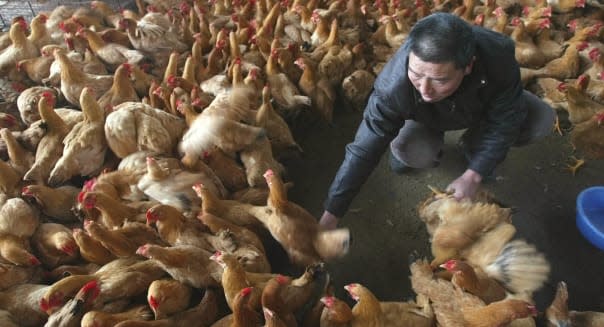Invasion of the Chinese Chickens: America's Looming Poultry Problem

Earlier this week, I outlined some of the changes that are in store if the USDA's proposed new poultry inspection program is put into action. In a nutshell, consumers can expect more chemicals sprayed on their chickens, fewer government meat inspectors, and more bacteria making it into their kitchens. But, as it turns out, there's an even bigger change headed down the pipeline: The USDA is also planning to allow Chinese poultry processing plants to export chicken to the U.S.
It's hard to overstate just how terrible an idea this is. To begin with, earlier this year, China had an outbreak of H7N9, the latest in a string of "bird flus" that have struck the country. The disease, which the World Health Organization describes as an "unusually dangerous virus for humans," is directly connected to poultry farming.
The CDC, by the way, warns -- somewhat obliquely -- that you can in fact catch these viruses from infected chicken meat. As their website notes in its Q&A section:
Can I get avian influenza from eating or preparing poultry or eggs?
You cannot get avian influenza from properly handled and cooked poultry and eggs.
(Underlining ours.) It then goes on to explain all the things you need to do to your poultry to stay safe from potential bird flu pathogens.
That's in sharp contrast to H1N1 "swine" flu, which you can't get from eating pork.
Tainted Food
Beyond that, China has a long history of selling tainted food. Within the last year, the country has had a poison rice scandal, a rat meat substituted for lamb scandal, a dead pig carcass scandal and -- seriously! -- a fake eggs scandal.
In the beginning, at least, the Chinese chicken will originate in America, but will be shipped overseas, processed, then shipped back. While the journey will ensure that the meat will come from certified poultry facilities, it will also consume a lot of fuel. And, as anybody who has kept pace with the meat processing scandals in the U.S. could attest, even meat that is raised and slaughtered domestically is far from guaranteed safe.
Ultimately, though, the chickens will be raised and slaughtered in China, far from U.S. inspectors. Supposedly, any tainted or unhealthy meat will be seized when it comes into U.S. ports.
Sponsored Links
Why would the USDA agree to this? Well, the answer is two-fold. First, despite efforts to increase productivity and decrease pay in American food lines, animal processing is still an expensive, labor-intensive activity. And labor is a heck of a lot cheaper in China.
Second, as Politico recently noted, there is a bit of tit-for-tat happening. In 2003, after a cow in Washington State was diagnosed with mad cow disease, China closed its borders to American beef. In the 10 years since then, Chinese beef consumption has gone through the roof. Right now, that demand is largely fulfilled by Uruguay and Australia, but U.S. farmers want in. In return for America's agreement on importing Chinese chicken, China may agree to open its markets to U.S. beef.
It will be a little while before China's chicken makes its way to America's tables. Then again, with the ever-decreasing regulation of America's poultry supply already under way, it's not too early to start amping up your food safety regimen at home. The Partnership for Food Safety Education offers solid guidelines, but the basics are pretty simple: Defrost chicken in the refrigerator or in a cold water bath, cook it to an internal temperature of 165 degrees F, and use separate plates for uncooked and cooked meat.
Another option is to buy organic chicken. On the downside, it's a little more expensive, and you still need to follow the same safety guidelines as with factory chicken. On the other hand, it will probably taste better than factory-farmed poultry, and it doesn't contain antibiotics or growth hormones. But spending that extra money will reduce your exposure to antibiotic-resistant bacteria -- a factor that, in the long run, could end up saving you a lot of money.
%Gallery-163223%
Bruce Watson is DailyFinance's Savings editor. You can reach him by e-mail at bruce.watson@teamaol.com, or follow him on Twitter at @bruce1971.

